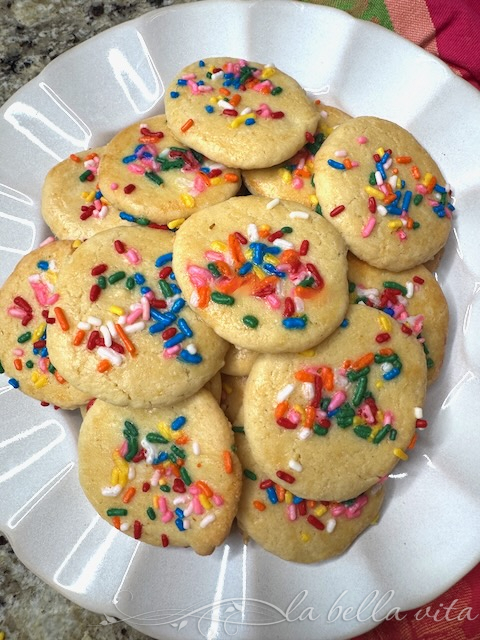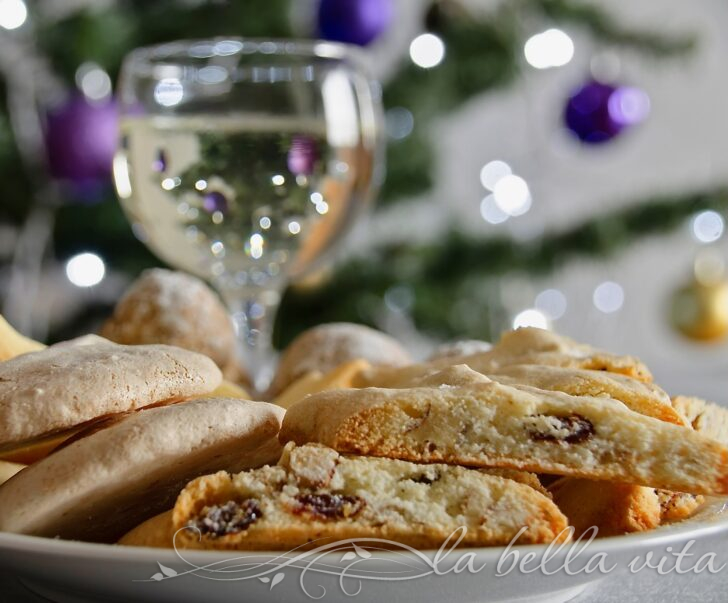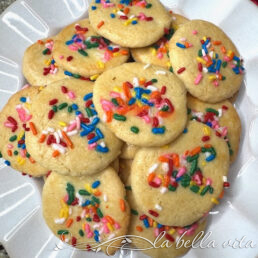Befanini – La Befana Italian Cookies for Epiphany

In Italy, the holiday season of Christmas and gift-giving doesn’t end until January 6th, with two big events: Epiphany and La Befana. It is a national holiday in Italy! Italians celebrate Christmas through the official 12th day of Christmas, which is Epiphany (the first day of Christmas is December 25th). Epiphany is the Christian holiday that commemorates the arrival of the three Magi (Wise Men/Kings) in Bethlehem, bearing gifts for baby Jesus.
Italians also celebrate Befana when children set out large stockings by the fireplace on the night before, January 5th, and anxiously wait through the night for La Befana to come and fill their stockings (calze) with presents and sweets. The gift-bearing La Befana is one of the favorite characters of children in Italy. Befana is a white-haired, old hag type of witch dressed in old, worn out, and tattered clothes who flies around on an old broom delivering candy, sweets, toys, and small gifts to all of the little ones.
It’s a tradition for La Befana to bring these nice presents to children who have been good. But those who have been naughty . . . she puts lumps of charcoal! in their shoes (scarpe). In reality, the coal is just dark candy, but it still sends a message! Yes, Italian children receive a few gifts on Christmas day, but it is the Befana who fills their stockings and not Santa. Her name, Befana, comes from the word “epifania,” which means epiphany.
La Befana is celebrated much more than Christmas with Babbo Natale (Father Christmas). However, today, Babo Natale delivers presents to Italian kids on Christmas Eve, too, but much less than what American children receive.
Who is La Befana?
There are many stories about how the Befana was included in the Christmas season in Italy. The origin and legend of the Befana date all the way back to ancient Rome, during the festival of Sauturnalia, when Romans would have their augers read by a wise old woman (crone/hag).

“Old Crone/Wise Woman” illustrations by Nicola Bayley (The Tyger Voyage, Richard Adams, 1976)
But beyond the thoughts and images of a friendly old witch flying around town delivering gifts to well-behaved children, it’s important to remember that a much deeper spiritual meaning is honored with La Befana:
The story of La Befana and its spiritual reflection of Epiphany is a beautiful but sad tale. According to the legend of La Befana and Christian folklore, when the Three Wise Men were on their way to Bethlehem to visit the newborn Christ child, they came to an Italian village located in the rugged hills.
It was nighttime, and they stopped at a cottage that was impeccably clean. They approached a friendly old woman who lived all alone in this little house and asked her for directions to get to Bethlehem. She did not know where Bethlehem was. But she did know that they had a long journey to go. The old lady was very kind and always welcoming to guests, so she invited them in for some refreshments and rest for the night before traveling on.
The Wise Men joyfully told her about the coming birth of a savior, the Christ child. The next day, before they continued on their journey, they asked her if she’d like to join them in finding the newborn king. But she declined and turned down their invitation because she was too busy sweeping and tidying up her cottage with all of her housework.
This is why La Befana is always shown with a broom.
A little bit later, a shepherd stopped by her pristine, clean cottage and asked Befana to join him in traveling to Bethlehem and paying respect to the baby Christ child. But once more, she refused.
And when nightfall came, she looked up and saw an unusually bright light in the sky. She believed it was an omen and, at first, did not understand its meaning. But then La Befana believed what the Wise Men and shepherd had told her.
La Befana thought she had made a mistake and should have gone with the Three Kings or the shepherd. Suddenly she changed her mind. So she quickly gathered up some treats and gifts to offer to the baby Christ child. She rolled them all up in a big cloth bag that she carefully tied to the end of her broom.
With these, she ran as fast as she could in search of the Wise Men and the shepherd. Sadly, La Befana never found any of them. But alas, she didn’t find the Wise Men, the shepherd, the stable, or the baby King.
After days of searching, the old woman turns around to return to her clean cottage. Just as she was giving up, a beautiful angel appears to her and tells her not to give up her search. The angel gives La Befana the gift of flying. So Befana gets on her old broom and flies off to once again find this special little baby. And again, she never finds Him and decides to return to her little cottage in the hills of Italy.
So, to this day, every year on the eve of Epiphany, La Befana takes flight on her broom in hopes that one day, she will find and adore this wonderful child. Since she cannot find Him, she flies around riding on her broomstick and continues her generosity.
She quietly enters every home in Italy with the hope that she will find Jesus and delivers gifts of toys and candy treats that she made in her big kettle (or chunks of charcoal) to children along her way because she regrets her decision not to go to Bethlehem. Some folklore says that La Befana now finds Christ in every young child.

photo credit: ornaoreilly.com
So Christmas may be over in America with all of the decorations already taken down. But in Italy, the festivities of the holiday PEAK on Epiphany and La Befana, when she makes her rounds on the night before the Feast of Epiphany and the Three Kings on January 6th. But the fun doesn’t stop there! The day is full of so many festivals and celebrations.
“Befana” is to Italian children, who Santa Clause is to American children. Instead of setting out milk and cookies, Befana expects to receive “una goccia di vino con i biscotti” (a glass of wine with a cookie)!

And this traditional cookie, known as Befanini, is enjoyed on the holiday. They are small and only about ¼ inch thick, and then glazed and decorated with sprinkles.

I have a new video in the creation stage that I hope to have uploaded in a few days!
Please Share the Love and Pin for Later !
In the meantime, here are some
More Italian Cookies You Might Enjoy:


Nutella Stuffed Snowball Cookies


Befanini – La Befana Italian Cookies for Epiphany
- Prep Time: 30 minutes
- Cook Time: 10 minutes
- Total Time: 40 minutes
- Yield: 25 – 30 cookies 1x
- Category: Cookies
- Method: Bake
- Cuisine: Italian
Description
Befanini are sweet little sugar cookies traditionally enjoyed in Italy in celebration of both the feast of the Epiphany and La Befana. They can be glazed and then decorated with colorful sprinkles or iced lightly and then sprinkled. Befanini are great for kids to have fun in the kitchen! They are best eaten the day that they are baked. They can be baked any time of the year, but traditionally, they are baked on January 5th, the night before Epiphany.
Ingredients
- 2 cups flour (Italian 00, if you don’t have any, use 50/50 all-purpose or pastry flour)
- 1 cup sugar
- 1 teaspoon baking powder
- pinch of salt
- 8 ounces butter, cold, cut into cubes or slices
- 1 large/jumbo egg
- zest of one lemon
- 1 teaspoon rum or lemon juice
- 1 tsp. vanilla extract
For the Glaze:
- 1 large/jumbo egg
- multi-colored sprinkles
For the Icing:
- 1 cup powdered/confectioners sugar
- 1 Tablespoon plus 2 teaspoons whole milk
- 1/2 teaspoon vanilla extract
- add a little bit of lemon juice if you like lemon
Instructions
For the Cookies:
- In a large bowl of a food processor, whisk the flour, sugar, baking powder, and salt together until it looks a little bit like cornmeal.
- Add the egg, vanilla extract, butter, and lemon zest (optional: add rum, or if preferred, add a few splashes of lemon juice)
- Pulse the ingredients together for about 1 minute or until the entire mixture begins to form a dough.
- Remove the dough from the bowl and form a complete ball with your hands.
- Wrap the ball of dough in cling plastic wrap and chill in the refrigerator for 1 hour or until it is firm enough to roll.
- Preheat the oven to 350 degrees. Line two baking sheets with parchment paper.
- Roll the dough ¼” inch thick on a lightly floured surface or wooden board, dusting the rolling pin with flour as well. Using cookie cutters, cut the dough into individual shapes. Place the cookies about ½” inch apart on the baking sheets. *** If you prefer glazed cookies, you do this at this point BEFORE baking, see step #9.
- Bake the cookies until they are lightly golden, 8 – 10 minutes. Allow the cookies to cool slightly on the baking sheets, and gently remove them with a spatula to a wire rack to cool completely. Repeat the process with the remaining dough until all the cookies are baked. *** If you prefer iced cookies and not glazed, you add icing at this point AFTER baking, see step #10.
To Make the Glaze OR Icing (one or the other):
- To make the glaze: Lightly whisk the egg yolk with the milk. Using a small pastry brush, lightly brush the surface of the cookies with a bit of glaze and decorate them with the sprinkles. Glaze and decorate BEFORE baking.
- For Icing: Whisk powdered/confectioners sugar with milk, vanilla extract together and if preferred, a a dash of lemon juice. ICE the cookies AFTER baking and then decorate with the sprinkles.
Notes
Storing the Befanini:
- The cookies may be stored in an airtight container, layered between sheets of parchment paper, for up to 5 days.
- They may be frozen for 3 months.
NOTE: If you prefer a light glaze, you do this BEFORE baking the cookies. However, if you prefer icing, then you do this AFTER baking the cookies.
Nutrition
- Serving Size: 1 cookie
- Calories: 75 calories
- Sugar: 3g
- Sodium: 75mg
- Fat: 3g
- Saturated Fat: 2g
- Unsaturated Fat: 0.2g
- Trans Fat: 0.1g
- Carbohydrates: 9g
- Fiber: 0.2g
- Protein: 1g
- Cholesterol: 14mg




I had not heard the complete story about Befana, it is such a sweet story. And speaking of sweet, the cookies sound terrific.
Pinned for La Befana next year ! Happy 2025. !
Love the story. I love learning about the Christmas traditions around the world. This is a beautiful Italian tradition. Love the cookies too.
Velva
OMG! I loved this post and the story about La Befana. I was not familiar with any of this type of celebrating in Italy. The cookies look wonderful and happy holidays and happy New Year.
What a kind old lady! The cookies look fantastic.
It’s a sweet story, isn’t it Angie!
Ciao,
Roz